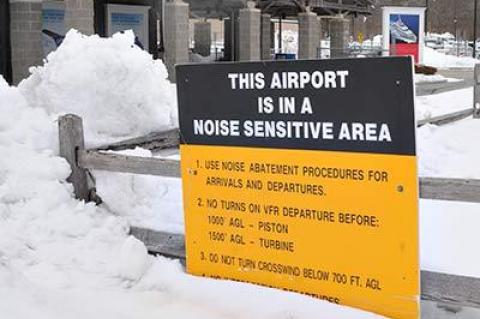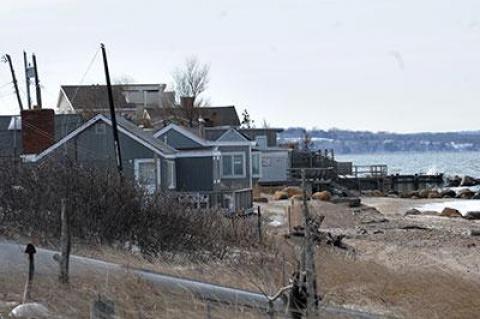East Hampton Town
C.P.F. on the Upswing
Concerned Citizens of Montauk is arguing that the Army Corps of Engineers plan to build a seawall along the ocean beach in downtown Montauk, for which bids have now been awarded, is not “shovel ready.”
“There’s a long list of items that need to be addressed,” Jeremy Samuelson, the executive director of C.C.O.M., said at an East Hampton Town Board meeting last Thursday. Mr. Samuelson is also quoted in a separate story on C.C.O.M.’s stand on a lawsuit challenging the project.
The remainder of a $31 million bond issued by East Hampton Town in 2006 will be refinanced, enabling the town to save $1.76 million in interest while paying off the debt over the next 12 years.
The money was borrowed for land acquisitions ($25 million), for construction of the town justice court ($2 million), and for the rehabilitation and reconstruction of the Montauk Playhouse Community Center ($4 million).
Almost 10 years later, the town has paid off almost $10 million of that debt, with $22.12 million remaining.
Assemblyman Fred W. Thiele Jr., who has been critical of PSEG-Long Island, the utility company that operates the Long Island Power Authority grid, for a number of its practices, is calling for a review of payments, including executive pay and fees to consultants and contractors, made by PSEG under its contract with LIPA.
 Opponents Head to Court to Block Montauk Sandbags
Opponents Head to Court to Block Montauk SandbagsA plan to build a 3,100-foot-long artificial dune along the downtown Montauk ocean beach will be challenged in court.
Repeated snowstorms this winter almost certainly have exacerbated the problem, but residents of East Hampton in the so-called urban renewal areas, many of which are in Springs, have been complaining for years about the state of their streets and the lack of town highway services for them, such as snow removal.
The roads in the urban renewal subdivisions are not part of the town’s public road system, and so tax money cannot be spent to repair, pave, or plow them, except in an emergency.
A lawsuit that challenged the adoption of a master plan for East Hampton Airport in 2010 has been dismissed by a federal appeals court. Brought by the Committee to Stop Airport Expansion, the suit centered on aircraft noise, which was the impetus for the four proposed airport use restrictions that drew a crowd to a town board hearing at LTV Studios in Wainscott last Thursday. The hearing is reported on separately.
Montauk’s Ditch Plain, where the future of what had been the East Deck Motel stirred recent interest in preserving its oceanfront tract, was before the East Hampton Town Zoning Board of Appeals on March 3 when applications to replace two mobile homes on the ocean at Montauk Shores Condominiums with two that would be larger came up for public hearing.
On the eastern side of Ditch Plain, Montauk Shores Condominiums is an unusual trailer park, with some of the 29 oceanfront units there reportedly valued in the neighborhood of $1 million.
A project to determine how much nitrogen is entering the Peconic Bay through groundwater and identify its specific sources, which has been under way since fall, will conclude next month. A joint venture of Cornell Cooperative Extension, the Peconic Land Trust, the Noank Aquaculture Cooperative, and the National Grid Foundation, the findings will be presented this summer.
Months after blueprints were drawn and its proposed location delineated, and well over a decade after discussions began, construction of a public restroom in the municipal parking lot north of Main Street in Amagansett is once again on hold.
A lawsuit against East Hampton Town, filed a year ago by a privately held drug treatment program in the Northwest Woods neighborhood, was dismissed on March 2 by a federal court judge in Central Islip. The judge, Leonard D. Wexler, found that Safe Harbor Retreat L.L.C. should have undergone a permitting process outlined in the zoning code before bringing the suit.
East Hampton Town
Contractor License Crackdown
A crackdown on unlicensed contractors working in East Hampton Town resulted in the arraignment on Monday of a dozen workers who had failed to obtain or carry with them the required town license.
Senator Charles Schumer spoke out this week about the utility poles installed by PSEG Long Island throughout East Hampton and across Long Island, calling a chemical used to treat the wooden poles “highly toxic” and “known to cause serious health issues,” and urging the federal Environmental Protection Agency to investigate its use immediately. He demanded that PSEG suspend the use of the chemical, penta, on utility poles, and halt further pole installation until the E.P.A. investigation is complete.
State Assemblyman Fred W. Thiele Jr. has been unremittingly critical of PSEG Long Island and LIPA, both for the utility company’s reluctance to discuss burying the high-voltage lines with East Hampton Village and Town, and because of the state-sanctioned handoff of Long Island’s electricity supply responsibilities from LIPA, which still owns the delivery infrastructure, to PSEG. Last month, he introduced legislation designed, he said, “to restore some degree of transparency and oversight to the activities of LIPA and PSEG-LI.”
 Airport Limits to Get Airing Tonight
Airport Limits to Get Airing TonightEast Hampton Town officials are bracing for a large turnout tonight at a hearing on four proposed regulations that would cut back on traffic to East Hampton Airport in order to reduce noise.
 Snowstorm Grounds East Hampton Airport Hearing
Snowstorm Grounds East Hampton Airport HearingA hearing on the proposed restrictions at East Hampton Airport has been rescheduled for March 12 because of Thursday's snowstorm.
The East Hampton Town Trustees and homeowners on trustee-managed land at Lazy Point in Amagansett are moving toward an agreement under which residents’ annual leases would rise by 10 percent this year, far below the trustees’ initial proposal of a fourfold increase, and there would be a doubling of the transfer fee, levied when a house is sold, to 4 percent.
Four laws designed to cut down the din from aircraft using the East Hampton Airport will be the subject of a hearing next Thursday and could take effect before the start of the busy season.
 Town Ban Sidestepped by State, Corps on Montauk Plan
Town Ban Sidestepped by State, Corps on Montauk PlanUnited States Army Corps of Engineers staff and New York State officials have sidestepped East Hampton Town in moving ahead with a planned multimillion-dollar project to protect the downtown Montauk ocean shoreline without obtaining local authorization.
A State Supreme Court judge has dismissed a lawsuit against East Hampton Town, its office of housing and community development, and the East Hampton Housing Authority over a mold infestation at the Windmill Village affordable housing complex.
Local municipalities can, and should, enact standards for septic systems that are more stringent than those upheld by the Suffolk County Health Department, which regulates septic waste systems throughout the county, Kevin McAllister, the founder of Defend H20 in Sag Harbor, told the East Hampton Town Board this week.
Several companies have introduced technology that can reduce the amount of nitrogen in the effluent released into the environment from septic systems — a key pollutant causing the deterioration of drinking and surface waters.
 Board Takes Stand Against Pump Canopy
Board Takes Stand Against Pump CanopyAlthough new pumps have been installed at the Empire Gas station, now Citgo, in Montauk and a pump island has been expanded, its application for site plan approval for the expansion remained in limbo on Feb. 4 when the members of the East Hampton Town Planning Board coalesced against a canopy for the island.
East Hampton Town
Montauk Beach: Easements Are In
East Hampton Town has obtained all of the needed agreements from the owners of Montauk properties along the downtown shore where the Army Corps of Engineers plans to build a reinforced sand dune.
Representatives for HomeGoods received a chilly reception from the East Hampton Town Zoning Board of Appeals last week as the board reviewed a request for signs on the new Wainscott building the store will occupy.
Town code limits total sign area to 20 square feet at that location, but HomeGoods wants to exceed that by nearly 50 percent, with a 14-square-foot sign on the back of the building by the parking lot and another one on the Montauk Highway side of the building.
Susan Knobel, who for more than a year has sought permission from the East Hampton Town Trustees to move her house from a severely eroded shoreline at Lazy Point in Amagansett, had reason to celebrate on Tuesday night. The trustees, who have debated the request while often asking for additional information, voted to authorize Ms. Knobel to apply for the variance relief that she will need from the East Hampton Town Zoning Board of Appeals to relocate her house to nearby lots that are at a higher elevation.
 Large Basements A Problem
Large Basements A ProblemCiting “the amount of money coming into the village, and what this money can do,” Mayor Paul F. Rickenbach Jr. and his colleagues on the East Hampton Village Board heard last Thursday about the mushrooming number of basements that extend beyond the footprints of their houses, providing more living space but also adding more “density.”
 Lazy Point Residents and Trustees Clash
Lazy Point Residents and Trustees ClashResidents’ anxiety over being priced out of the modest houses they own on land they lease from the East Hampton Town Trustees at Lazy Point in Amagansett was evident during a lengthy and sometimes tense meeting on Tuesday night, with accusations heard that the members of the panel were continuing to be adversarial and belligerent.
The trustees had previously announced their intention to raise annual leases to $6,000 per lot per year. Leaseholders now pay $1,500 per year.
The economy of East Hampton Town — how money is made, from whom, and the needs of consumers and businesses — will be the subject of a study to be commissioned by the East Hampton Town Board.
Copyright © 1996-2024 The East Hampton Star. All rights reserved.